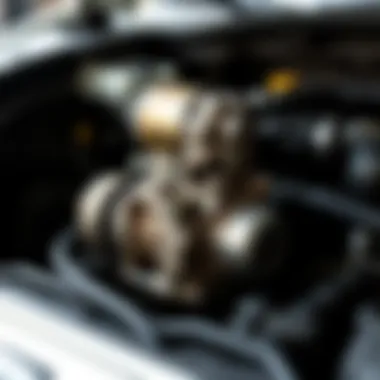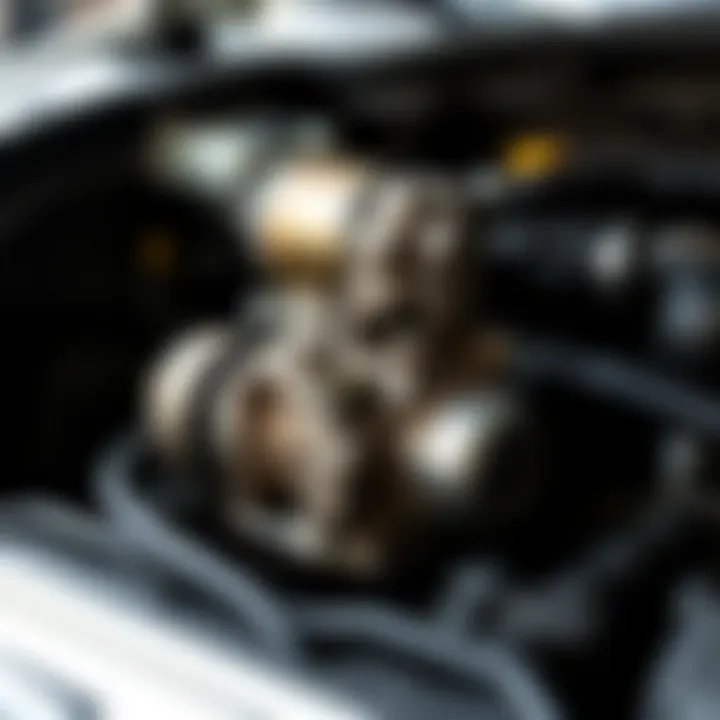Common Starting Issues in the 2014 Hyundai Elantra


Intro
The 2014 Hyundai Elantra is a popular compact sedan known for its stylish design and solid performance. However, like many vehicles, it is not without its fair share of problems. Starting issues can be particularly frustrating for owners, causing not only inconvenience but also raising concerns about the vehicle’s reliability. In this article, we will investigate the common starting problems that may plague the 2014 Elantra, examining various potential causes and solutions. This exploration will allow automotive enthusiasts, potential buyers, and professionals to gain valuable insights into troubleshooting these starting issues effectively.
Understanding the mechanics behind why a vehicle might falter when starting is crucial. From the battery to the starter motor, the ignition system, and the fuel delivery system, numerous components work in conjunction, and a fault in any one of them can hinder the starting process. With the right knowledge and tools, diagnosing these problems can be much easier. As we dive into the intricacies of the 2014 Elantra's starting issues, we aim to arm you with tips, insights, and information that empower informed decisions and effective repairs.
Performance Metrics
When discussing starting issues in the Hyundai Elantra, it’s important to consider its overall performance metrics, including aspects such as fuel efficiency and handling.
Fuel Efficiency
The 2014 Elantra boasts impressive fuel efficiency, achieving approximately 26 mpg in the city and up to 38 mpg on the highway. However, when the vehicle faces starting problems, it could lead to a chain reaction affecting fuel efficiency. For instance, a malfunctioning fuel pump might not supply sufficient gasoline to the engine, resulting in poor performance and increased fuel consumption. If you find your Elantra struggling to start, it's worth considering whether the fuel delivery system may be implicated in the issue.
Handling and Stability
In terms of handling, the Elantra provides a smooth drive and solid stability on the road. However, starting problems can sometimes translate into poor handling characteristics. For example, if the battery is weak, the electrical systems—including power steering—may not operate effectively. This can make maneuvering the vehicle more difficult. Owners must understand that it's not just about getting the car started; it's also about ensuring the car performs well once it does.
In addition to performance metrics, discussing the common starting issues sheds light on how vital it is to maintain the vehicle regularly. Keeping an eye on the health of the battery, monitoring the fuel system, and addressing any quirks promptly can prevent minor irritations from ballooning into significant concerns.
In the next sections, we will detail more specific components and symptoms related to the starting problems of the 2014 Hyundai Elantra, ensuring a thorough understanding of what owners might encounter.
Overview of the Hyundai Elantra
The 2014 Hyundai Elantra is a compact car that blends style, comfort, and efficiency. For many potential buyers, it stands out in a crowded market, showing a unique combination of features and specifications that appeal to an array of drivers. Knowing these elements helps illuminate the practical implications of starting problems that might occur as the vehicle ages.
In this article, we delve into the significance of understanding the specifications and features of the Elantra, especially for those who are currently driving or considering one of these vehicles. Having a good grasp of what makes up the 2014 Elantra not only aids in identifying faults but also enhances the overall ownership experience.
General Specifications
The 2014 Hyundai Elantra is built on a solid foundation, integrating modern engineering with aesthetic appeal. Overall, it spans a length of about 179 inches, standing roughly 56 inches tall, making it compact enough for urban driving but spacious enough for comfortable rides.
- Engine: The vehicle typically comes equipped with a 1.8-liter four-cylinder engine, providing a balance between power and fuel efficiency. It delivers around 148 horsepower, which is adequate for daily commuting.
- Transmission Options: Buyers had options, like a six-speed manual or a six-speed automatic transmission, giving flexibility based on driver preference.
- Fuel Economy: When it comes to fuel economy, the Elantra shines, achieving around 27 miles per gallon in the city and up to 38 mpg on the highway, catering to eco-conscious drivers.
These specifications reveal how the Elantra is tailored for everyday use while ensuring efficiency and comfort.
Common Features
The 2014 Elantra hosts a variety of features that set it apart from competitors, focusing on user convenience and technology integration. Some notable specifications include:
- Interior Comfort: The cabin possesses ample space, designed with high-quality materials. Front seats often come with standard adjustments, offering comfort for both short and long rides.
- Infotainment System: Most models are equipped with a user-friendly touchscreen interface, Bluetooth connectivity for hands-free calling, and audio streaming—an increasingly essential feature for tech-savvy drivers.
- Safety Ratings: The vehicle is known for robust safety ratings, reporting high scores in crash tests which gives buyers peace of mind during use.
Understanding these features and specifications provides the groundwork for discussing the potential starting problems that may be encountered. Recognizing what to expect will enhance troubleshooting efforts and help maintain the vehicle's performance over time.
Understanding Starting Problems
Starting problems in a vehicle can be a source of frustration for any driver, particularly with the 2014 Hyundai Elantra. Understanding these issues is not merely about fixing a car; it’s about grasping how various components interact to start the engine, ensuring smooth performance and reliability. Addressing starting problems allows owners to avoid being stranded at inconvenient times, and it empowers them with knowledge that can be invaluable during maintenance. Additionally, understanding these problems has financial implications, often preventing costly repairs down the line.
Definition and Symptoms


Starting problems typically refer to difficulties that a vehicle experiences when trying to turn on the engine. Owners may notice several key symptoms:
- No Crank Condition: When the ignition is turned, nothing happens; the engine fails to crank. It’s like turning the key in an empty lock.
- Slow Cranking: In this scenario, the engine attempts to start but takes longer than usual. It’s akin to a friend trying to turn on a stubborn light switch.
- Engine Lights: Dashboard warning lights may illuminate, signaling issues that need attention.
- Clicking Sound: Instead of the engine starting, some drivers may hear a clicking noise. This could mean the starter motor is unable to kick into action, much like a weak battery on its last legs.
- Fuel Odor: A fuel smell might indicate that your vehicle is trying to start but isn’t getting adequate fuel flow. Understanding these symptoms helps in pinpointing the cradle of the trouble early on.
Impact on Vehicle Performance
The implications of starting problems can ripple through the overall vehicle performance. When an engine fails to start reliably, it can lead to:
- Increased Wear and Tear: Frequent failed starts can put unnecessary stress on the starter motor and fuel system components.
- Diminished Fuel Efficiency: Problems within the ignition or fuel delivery systems can lead to inefficient combustion, complicating fuel economy.
- Compromised Electrical System: Electrical components tied to starting issues can cause erratic behavior in other systems, creating a domino effect.
"Diagnosing starting problems early can save both time and money, preventing a small issue from becoming a major headache in the long run."
Drivers might also find that unresolved starting issues can ultimately affect their confidence in vehicle reliability. After all, biting nails while waiting for your car to start can overshadow the joy of driving. Thus, paying attention to the early indicators of starting problems is crucial for any Hyundai Elantra owner.
Potential Causes of Starting Issues
Understanding the root of starting problems in the 2014 Hyundai Elantra is crucial for owners and potential buyers alike. Identifying potential causes can save significant time and money when it comes to troubleshooting and repairs. The Elantra, like any vehicle, relies on several systems working in harmony to initiate the ignition process. When even one component falters, it can lead to vexation and inconvenience. Delving into specific causes helps drivers become more informed and prepared, ultimately enhancing their car experience.
Battery Problems
Electrical Connections
Electrical connections are often where trouble begins when addressing starting issues. A loose or corroded connection can prevent your Elantra from receiving the necessary power to start. This aspect is essential because without a solid connection, even a fully charged battery might fail to deliver juice to the starter motor. The key characteristic here is that these connections can wear out over time due to vibration, weather, or corrosion. That’s why keeping the terminals clean and securely fastened is a practical choice for preventing unnecessary headaches. However, it's not always so straightforward. If corrosion builds up, it may indicate a deeper issue within the battery or wiring itself, which could complicate troubleshooting.
Battery Age and Condition
The age and condition of the battery is another factor that looms large in starting issues. Batteries typically have a lifespan of around three to five years, so knowing how old yours is can be a game-changer. An aging battery can struggle to put out the required voltage, leading to sluggish starts. This makes battery condition a primary focus for our investigation. For instance, a battery that tends to swell or show leaks is not going to perform well. In this article, we highlight how performing regular tests on your battery will provide insight into its health, possibly saving you from being stranded unexpectedly.
Starter Motor Failures
Signs of Starter Malfunction
Starter malfunctions can throw a wrench in the works of a perfectly good vehicle, and knowing the warning signs is half the battle. Common indicators include a clicking noise when you turn the key or a short spin of the starter. These could signal that the starter is on its last legs. This topic is relevant, as many Elantra owners have reported such issues, which can stem from various internal failures within the starter itself. Diagnosing these signs promptly can keep you from being left high and dry on a cold morning.
Replacement Options
When starter failures do occur, knowing the replacement options available is incredibly valuable. Home mechanics can choose between original equipment manufacturer (OEM) parts or aftermarket alternatives that may save them a few bucks. Choosing OEM ensures quality and compatibility, important aspects that enhance reliability. However, some aftermarket parts come with warranties and can often be just as effective if you do your homework. Understanding these choices allows for informed decisions that suit both your budget and performance expectations.
Ignition System Malfunctions
Ignition Coil Issues
The ignition coil plays a pivotal role in generating the spark needed to ignite the fuel-air mixture in the engine. Issues with the ignition coil can lead to hard starting, misfires, and reduced overall performance. This makes it essential to recognize when the coil might be faltering. A key characteristic of ignition coil failure is often seen in decreased fuel efficiency or increased emissions. Those are red flags that shouldn’t be ignored. Addressing these issues early can save you from a headache down the line.
Spark Plug Condition
The condition of your spark plugs is equally critical, as worn or fouled plugs can also lead to uncouth starting behavior. A simple visual inspection can often reveal a lot. If they appear dirty or worn, it’s time to replace them. Spark plugs should be changed according to the maintenance schedule to avoid long-term problems. Their unique design allows them to handle high temperatures, but they don't last forever. Remember, bad spark plugs can lead to increased fuel consumption and operational inefficiencies, so keeping them in check is wise.
Fuel Delivery Problems
Fuel Pump Failure


Fuel pump failure is a lesser-discussed cause, but it can be a significant player in starting troubles. When the fuel pump doesn’t work right, it can disrupt fuel flow, causing the engine to stutter or fail to start altogether. This issue warrants careful attention, especially if you hear unusual noises from the fuel tank. That’s a clear sign something might be amiss. Identifying fuel pump problems becomes essential in maintaining overall vehicle efficiency and performance.
Clogged Fuel Filter
A clogged fuel filter is another common suspect when investigating starting problems. It can obtrude fuel flow, leading to a myriad of performance issues. The crux of this issue lies in the fact that fuel filters should be replaced periodically—neglecting this routine can lead to complications more significant than a mere inconvenience. By keeping an eye on this component, you ensure that the engine receives sufficient fuel to start smoothly, avoiding frustrating delays and unexpected breakdowns.
User Experiences and Testimonials
User experiences and testimonials are invaluable elements in understanding the real-world performance of the 2014 Hyundai Elantra, particularly regarding starting problems. These firsthand accounts not only highlight common issues but also shed light on various strategies to troubleshoot them effectively. When potential buyers or current owners discuss their experiences, they contribute to a collective knowledge pool that can aid drivers in making informed decisions.
Common Complaints
When it comes to starting issues in the 2014 Hyundai Elantra, several complaints repeatedly emerge from drivers. Here are a few of the most prevalent:
- Unresponsive Ignition: Many owners find that their vehicle won't start, receiving no response when turning the key. This can often be attributed to battery problems or starter motor failures.
- Intermittent Starting Failures: Some Elantra drivers report that their car starts fine most of the time but occasionally fails to respond. This inconsistency can lead to frustration and anxiety, particularly if it occurs at inopportune times.
- Check Engine Light: A common sign of starting issues is the appearance of the check engine light. This can indicate various underlying problems, including issues with the ignition or fuel delivery systems.
- Clicking Sound: A clicking noise when attempting to start the engine can indicate a weak battery or issues with electrical connections.
These complaints signal a need for thorough investigations into specific components of the vehicle, which often leads drivers to seek out solutions or repairs.
Successful Troubleshooting Stories
Counterbalancing the complaints are numerous success stories from those who have navigated their way through starting issues in their 2014 Hyundai Elantra. Here are some noteworthy examples:
- DIY Battery Replacement: One Elantra owner shared how they diagnosed a starting issue related to an old battery. After conducting some basic tests using a multimeter, they discovered that the battery voltage was below optimal levels. Opting for a new battery led to a quick and effective resolution, bringing the car back to life.
- Ignition Coil Replacement: Another driver recounted their experience with persistent starting delays. After some research and consultation with fellow Hyundai enthusiasts on forums like Reddit, they learned that faulty ignition coils could be the culprit. Replacing the coils resulted in immediate improvements in starting performance and fuel efficiency.
- Fuel Pump Inspection: Some drivers caught the symptoms of fuel pump failure early. They shared how noticing unusual sounds from the fuel tank prompted them to replace the pump before it completely failed. This proactive approach not only saved them from being stranded but also ensured better engine performance.
In summary, these testimonials enrich the understanding of starting problems faced by 2014 Hyundai Elantra owners. They not only serve as a cautionary tale but also illustrate the power of community knowledge. As potential buyers or current owners peruse these experiences, they gain insight into maintaining their vehicles better and recognizing the early signs of trouble.
Remember: Engaging with other car owners can provide valuable perspectives that manuals and diagnostics might overlook.
For anyone struggling with similar issues, these stories emphasize the importance of staying informed and proactive in vehicle maintenance.
Diagnostic Techniques for Engineers
Diagnosing starting problems in vehicles, especially in a specific model like the 2014 Hyundai Elantra, requires a methodical approach. This is where diagnostic techniques come into play. Understanding these techniques is crucial for engineers and mechanics, as they not only help identify the root of issues but also streamline repairs. The ability to accurately diagnose problems can save time, reduce unnecessary labor costs, and enhance the reliability of the repair process.
Using Diagnostic Tools
Tools can make or break the diagnostic process. Having the right equipment readily available enables quick evaluation of common issues faced by the Elantra.
OBD-II Scanner Applications
A significant aspect of diagnostic tools is the OBD-II scanner. The On-Board Diagnostics II (OBD-II) system is a standardized vehicle diagnostic tool that has been the gold standard for over a couple of decades. When it comes to starting problems, using an OBD-II scanner can pinpoint trouble codes directly related to engine performance and fuel delivery issues. The scanner's ability to pull specific error codes allows for targeted troubleshooting, making it a popular choice among engineers.
One key characteristic of OBD-II is its versatility; not only does it cover emissions-related issues, but also encompasses areas affecting vehicle starting and running conditions. Its compatibility across multiple vehicle makes adds to its reliability in mixed environments.
- Advantages: Quick diagnostics, compatibility with many vehicles, and ability to read real-time data.
- Disadvantages: Some models may require manufacturer-specific adapters, and interpretation of codes can sometimes be misleading.
Multimeter Usage
Another fundamental tool for automotive diagnostics is the multimeter, used for measuring voltage, current, and resistance. Its contribution to identifying electrical issues in starting systems such as the battery and starter motor is invaluable. By checking voltage drops in various components, technicians can evaluate if power is reaching critical areas effectively.


A defining feature of the multimeter is its ability to diagnose both AC and DC circuits, allowing for a comprehensive examination of the vehicle’s electrical systems.
- Advantages: Versatile for a range of electrical diagnostics and provides precise readings.
- Disadvantages: Requires some technical knowledge to use effectively; incorrect usage can lead to missed problems or misdiagnoses.
Step-by-Step Diagnostic Guide
Having an overview of how to approach diagnostics means that engineers can efficiently tackle starting issues. A typical step-by-step guide might include the following steps:
- Initial Visual Inspection: Check for obvious issues like loose wires or corrosion around the battery terminals.
- Scan for Codes: Utilize the OBD-II scanner to retrieve any error codes that might indicate where the issue lies.
- Electrical Testing: Employ the multimeter to assess battery voltage and starter connections. Ensure power is getting to the starter motor.
- Component Isolation: If no issues arise from previous checks, isolate components such as the ignition and fuel systems for further testing.
- Final Evaluation: Conclude with a thorough inspection of all connections to ensure everything aligns with the manufacturer specifications.
Evaluating these diagnostic techniques not only helps in understanding vehicle mechanics better but also empowers professionals with the know-how to address common problems that plague the 2014 Hyundai Elantra. Together, these tools provide a solid foundation for troubleshooting and repairs, saving both time and effort in the long run.
"A stitch in time saves nine." This adage reminds us that diagnosing correctly the first time prevents bigger headaches down the road.
Repair and Maintenance Recommendations
When diving into the intricacies of starting problems in the 2014 Hyundai Elantra, it's crucial to also discuss repair and maintenance recommendations. Engaging in proper maintenance can prevent many issues from arising, saving drivers time and money in the long run.
Regular upkeep not only ensures the vehicle operates efficiently but also prolongs its lifespan. A well-maintained car can avoid the headaches often associated with starting issues, which stem from various components that wear out or degrade over time. Here’s a closer look at some essential maintenance practices and considerations when dealing with starting problems.
Routine Maintenance Practices
Performing regular maintenance can help maintain the vehicle's overall health and prevent potential starting issues. Below are key practices that every Elantra owner should incorporate into their routine:
- Battery Inspection: Check the battery regularly for any signs of corrosion on terminals. Clean them, if necessary, to ensure a good connection.
- Fluid Levels: Ensure that engine oil, coolant, and other essential fluids are at the right levels. Low fluids can lead to engine inefficiency and starting troubles.
- Filter Changes: Don’t neglect the fuel and air filters. Clogged filters can starve the engine of the necessary components needed during ignition, potentially causing a failure to start.
- Spark Plug Replacement: Replacing spark plugs at the recommended intervals can prevent ignition problems. Worn-out plugs may cause misfires that impact starting performance.
- Tire Checks: While it may seem unrelated, proper tire maintenance can affect overall vehicle handling and performance, including during the start. Make sure they are properly inflated.
- Regular Testing: Consider using an OBD-II scanner to check for any error codes that may hint at underlying issues within the vehicle’s systems.
These practices, though seemingly simple, can make a significant difference. As they say, "an ounce of prevention is worth a pound of cure."
When to Seek Professional Help
Navigating vehicle repairs can often feel like you’re wandering through a maze, particularly when starting problems arise. While routine maintenance can fix many minor issues, some situations may require the expertise of a professional mechanic. Here are some indicators that it’s time to call in the pros:
- Persistent Starting Issues: If you've followed the routine practices but still face troubles, there may be deeper issues at play that need advanced troubleshooting.
- Unusual Sounds: Strange noises when attempting to start the vehicle can indicate problems with the starter or other components that require immediate attention.
- Warning Lights: If any warning lights illuminate on the dashboard, it's a sign that the vehicle needs inspection. Don't ignore these alerts—the car likely knows something you do not.
- Battery Failures: If the battery is new but still causing problems, professional testing might reveal deeper electrical system issues.
- Complex Repairs: If the diagnostics indicate possible ignition system failures, fuel system problems, or electrical complications, those are best handled by experienced hands.
Investing in professional help at the right time can save a lot of headaches in the future. Remember, a stitch in time saves nine!
In summary, regular maintenance and knowing when to seek professional help are pivotal in ensuring the 2014 Hyundai Elantra starts smoothly every time.
By staying on top of these recommendations, Elantra owners can enjoy a reliable vehicle with minimal starting woes, ultimately leading to a safer and more enjoyable driving experience.
Culmination
The exploration of starting problems in the 2014 Hyundai Elantra is not just an academic exercise; it signifies an essential guide for countless owners and potential buyers. Understanding these issues plays a critical role in ensuring smooth vehicle operation and enhancing overall reliability. Among the significant concerns highlighted are the battery health, the starter motor’s functionality, the integrity of the ignition system, and the proper operation of the fuel delivery system. Each element can either contribute to a seamless start or throw a wrench in the works, leaving drivers stranded.
By synthesizing user experiences and technical insights, this article serves as a handy reference. It’s about empowering the automotive enthusiast with knowledge, enabling informed decisions that can lead to favorable outcomes—whether it’s a straightforward DIY repair or when to hand over the wrench to a trained mechanic.
Moreover, this knowledge extends to financial considerations as well. Properly diagnosing and addressing these common issues can lead to savings over time. Early detection of problems means potentially avoiding more extensive and costly repairs down the road, which often see individuals digging deeper into their pockets than anticipated.
Summary of Key Points
- Battery Health: Regular checks and maintenance of the battery can prevent starting issues. Look out for corrosion and ensure connections are tight.
- Starter Motor Functionality: Recognizing early signs of starter motor failure, like clicking sounds or slow turnover, can be vital for timely intervention.
- Ignition System Condition: Regular inspection of spark plugs and ignition coils ensures that the engine receives a strong spark for optimal combustion.
- Fuel Delivery System: Regular replacement of fuel filters and checking fuel pump operation can prevent frustrating failures in fuel delivery.
Final Thoughts on Reliability
The 2014 Hyundai Elantra, while generally praised for its reliability, is not without its quirks and challenges, particularly when it comes to starting. Owners must remain vigilant and proactive in maintaining their vehicles.
In the grand scheme, understanding these starting problems could significantly impact the driving experience. Knowledge not only offers peace of mind but also cultivates a responsibility towards the vehicle's well-being. With the right information at hand, drivers of the Elantra can look forward to smooth operations and fewer unplanned visits to the mechanic. It’s about cultivating a long-lasting relationship with a vehicle that serves its purpose faithfully and dependably.



